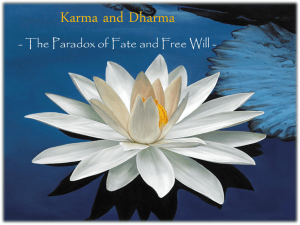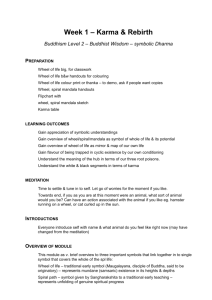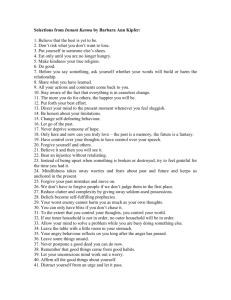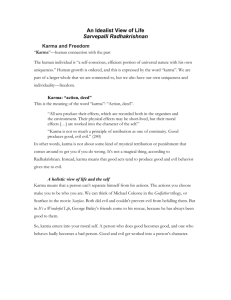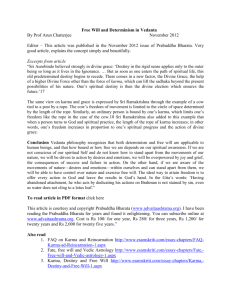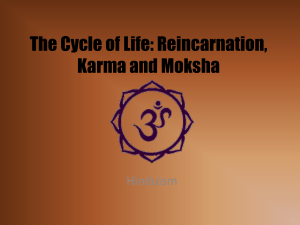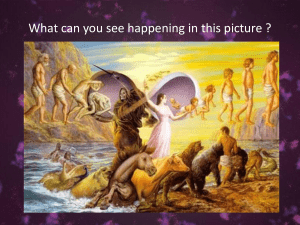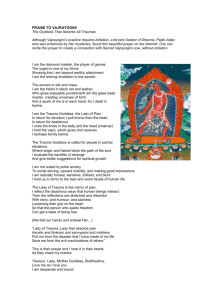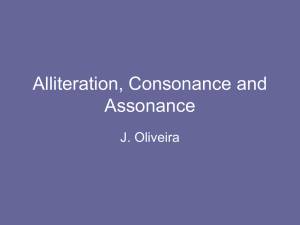Science of Human Happiness - essay version
advertisement
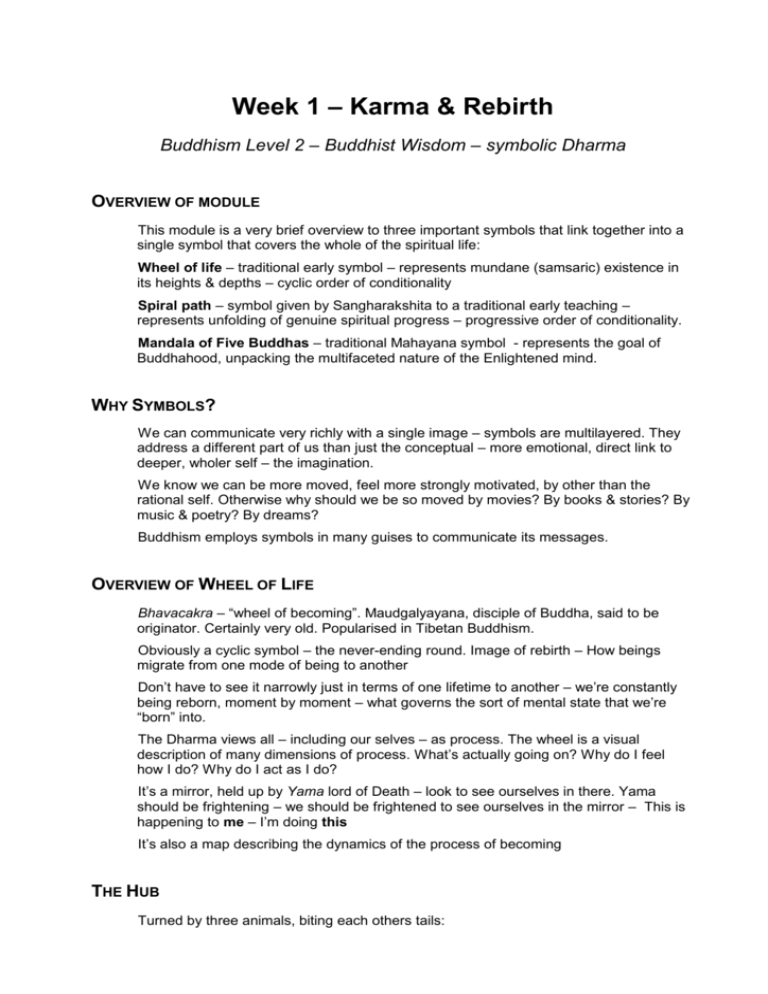
Week 1 – Karma & Rebirth Buddhism Level 2 – Buddhist Wisdom – symbolic Dharma OVERVIEW OF MODULE This module is a very brief overview to three important symbols that link together into a single symbol that covers the whole of the spiritual life: Wheel of life – traditional early symbol – represents mundane (samsaric) existence in its heights & depths – cyclic order of conditionality Spiral path – symbol given by Sangharakshita to a traditional early teaching – represents unfolding of genuine spiritual progress – progressive order of conditionality. Mandala of Five Buddhas – traditional Mahayana symbol - represents the goal of Buddhahood, unpacking the multifaceted nature of the Enlightened mind. WHY SYMBOLS? We can communicate very richly with a single image – symbols are multilayered. They address a different part of us than just the conceptual – more emotional, direct link to deeper, wholer self – the imagination. We know we can be more moved, feel more strongly motivated, by other than the rational self. Otherwise why should we be so moved by movies? By books & stories? By music & poetry? By dreams? Buddhism employs symbols in many guises to communicate its messages. OVERVIEW OF WHEEL OF LIFE Bhavacakra – “wheel of becoming”. Maudgalyayana, disciple of Buddha, said to be originator. Certainly very old. Popularised in Tibetan Buddhism. Obviously a cyclic symbol – the never-ending round. Image of rebirth – How beings migrate from one mode of being to another Don’t have to see it narrowly just in terms of one lifetime to another – we’re constantly being reborn, moment by moment – what governs the sort of mental state that we’re “born” into. The Dharma views all – including our selves – as process. The wheel is a visual description of many dimensions of process. What’s actually going on? Why do I feel how I do? Why do I act as I do? It’s a mirror, held up by Yama lord of Death – look to see ourselves in there. Yama should be frightening – we should be frightened to see ourselves in the mirror – This is happening to me – I’m doing this It’s also a map describing the dynamics of the process of becoming THE HUB Turned by three animals, biting each others tails: Cock – greedily pecking for food - lust or craving Snake – image of malicious harm – hatred or aversion Pig – eyes obscured by ears – ignorance or delusion These are the driving forces of the wheel – of the reactive mind - and the sources of our suffering. But its counterproductive to respond with aversion to our nature – need to accept our basically animal natures & animal drives. Don’t wage war with self, but look for ways to accommodate & transform limitations. We have potential for the opposites of the poisons: Generosity / contentment, love, wisdom. THE BLACK & WHITE SEGMENTS Shows beings evolving according to their karma: skilful actions tending towards pleasant, happy outcomes; unskilful tending towards unpleasant, painful outcomes Stark – all the time only have two choices – skilful or unskilful. Sobering – do we tend to think that most of what we do is somehow “neutral”, won’t really make a difference somehow? Karma Everything we do – through affects us, modifies our being in some way : Underlying motivation Karmic quality Outcome Greed, hatred, delusion Unskilful Unhappy – lower state of being Generosity, love, wisdom Skilful Happier – higher state of being Not everything that happens to us is caused by our karma, but everything we do, say or think creates karma and will have an effect, certainly on us and probably on the world around us. There’s no Supreme Being administering justice: karma is a model that describes the natural workings of the psychical universe. So we talk of skilful and unskilful rather than good & bad: there’s no one “up there” judging us, to whom we’re responsible. Confidence in karma is one of chiefs objects of faith for a Buddhist – to extent that if at gut level we really believe that actions have consequences, we will will be that much more motivated & energised to practice. Most reluctance or lack of energy in practice / meditation is really just doubt – lack of conviction that it will make a difference, or that one’s current disengaged mental state is at best a missed opportunity. Karma is our one true possession: Beings are owners of their karma, heirs of their karma, karma is the womb from which they are born. Their karma is their friend and their refuge. Whatever karma they perform, good or bad, of that they will be heirs Majjhima Nikaya 135 Karma defines us and our future happiness more strongly than our possessions, our looks, our family, wealth etc Cambridge Buddhist Centre 2 Rebirth If see ourselves as a process of continual change, one moment of being conditioning the next, then not such a big deal to see the end of one life conditioning the beginning of the next. No fixed “I” that moves from one to the next, but tendencies conditioning tendencies HOME PRACTICE Trying to gain a sense of how we’re “reborn” each moment depending on our karma: Try to notice a couple of times per day moments of karma (we’re doing it all the time!), and work out whether you’re in the black or white segment. If you’re “in the white”, ie being aware, skilful & creative, then you’ll probably notice it as you’re doing it. If you’re in the black, ie being unskilful & reactive, then you may not realise until afterwards, maybe by how you feel. Is there any connection between how you feel later and the quality of the karma? And, if you like, start colouring in your wheel of life! RESOURCES FOR THE COURSE Recommended books The Wheel of Life, Kulananda (short & pithy) ch 1-3 The Buddhist Vision, Subhuti (more in-depth, covers whole module) ch 4 & 5 Karma & Rebirth, Nagapriya (contemporary, critical account) On the web Interactive wheel of life (needs Explorer) http://www.angelfire.com/yt/fairtibet/whexpl.html More detailed wheel of life exposition with good images http://www.kheper.net/topics/Buddhism/wheeloflife.html Sutta and essay on how the wheel & spiral path are connected: http://accesstoinsight.org/lib/authors/bodhi/wheel277.html Other What is the Dharma, Sangharakshita, ch 2 Karma & Rebirth, Sangharakshita, CD 032. Long, thorough account of traditional accounts of karma and rebirth. Cambridge Buddhist Centre 3

